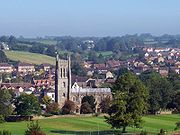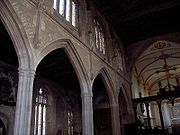
Bruton Abbey
Encyclopedia


Bruton
Bruton is a town and civil parish in Somerset, England, situated on the River Brue seven miles south-east of Shepton Mallet, just south of Snakelake Hill and Coombe Hill, ten miles north-west of Gillingham and twelve miles south-west of Frome in the South Somerset district. The town has a...
, Somerset
Somerset
The ceremonial and non-metropolitan county of Somerset in South West England borders Bristol and Gloucestershire to the north, Wiltshire to the east, Dorset to the south-east, and Devon to the south-west. It is partly bounded to the north and west by the Bristol Channel and the estuary of the...
was originally founded as a Benedictine
Benedictine
Benedictine refers to the spirituality and consecrated life in accordance with the Rule of St Benedict, written by Benedict of Nursia in the sixth century for the cenobitic communities he founded in central Italy. The most notable of these is Monte Cassino, the first monastery founded by Benedict...
priory by Algar, Earl of Cornwall in about 1005. It was subsequently refounded as a house of Augustinian canons in 1135, by William de Mohun, who later became the Earl of Somerset. The village used the north aisle of the priory church as their parish church. It was endowed with manors, churches and other properties in the area and also in Normandy in France.
History
In 1260 the priory exchanged its French possessions for land held by the Abbey of Troarn (nr CaenCaen
Caen is a commune in northwestern France. It is the prefecture of the Calvados department and the capital of the Basse-Normandie region. It is located inland from the English Channel....
) at Runcton in Sussex
Sussex
Sussex , from the Old English Sūþsēaxe , is an historic county in South East England corresponding roughly in area to the ancient Kingdom of Sussex. It is bounded on the north by Surrey, east by Kent, south by the English Channel, and west by Hampshire, and is divided for local government into West...
and in Gloucestershire
Gloucestershire
Gloucestershire is a county in South West England. The county comprises part of the Cotswold Hills, part of the flat fertile valley of the River Severn, and the entire Forest of Dean....
.
There were many problems reported in the 15th century. John Schoyle became prior in 1419 and was accused in 1423 of having committed serious offences. In 1428 Bishop Stafford seems to have removed Schoyle from office, and in 1429, the latter was sent to live at the house of Augustinian Canons at Poughley in Berkshire
Berkshire
Berkshire is a historic county in the South of England. It is also often referred to as the Royal County of Berkshire because of the presence of the royal residence of Windsor Castle in the county; this usage, which dates to the 19th century at least, was recognised by the Queen in 1957, and...
. His successor, Richard of Glastonbury, proved to be equally troublesome: in 1430 and again in 1444, inquiries were conducted into charges of immorality against the prior and the whole community. Under a later reforming prior various rules were introduced bans on the canons were sleeping away from the house without permission, on hunting and dice playing, and on women in the monastery.
Bruton became an abbey in 1511. There were problems both inside and outside the monastery leading up to its dissolution in 1539. The abbot, Ely, was the subject of criminal accusations and even plots against his life, and later in the year became a prisoner in the Tower of London
Tower of London
Her Majesty's Royal Palace and Fortress, more commonly known as the Tower of London, is a historic castle on the north bank of the River Thames in central London, England. It lies within the London Borough of Tower Hamlets, separated from the eastern edge of the City of London by the open space...
.
After Dissolution
On dissolution, the abbey was granted to a John Drew of Bristol, but later transferred to Sir Maurice Berkeley. The latter built a house on the site incorporating some of the buildings, but this was demolished in 1786. Sir Maurice was a prominent courtier and his impressive RenaissanceRenaissance
The Renaissance was a cultural movement that spanned roughly the 14th to the 17th century, beginning in Italy in the Late Middle Ages and later spreading to the rest of Europe. The term is also used more loosely to refer to the historical era, but since the changes of the Renaissance were not...
-inspired tomb and those of his wives are retained in the later chancel. The present parish church is mainly a 14th-15th century structure. An unusual feature is that the chancel at some point was rebuilt in a light, airy Georgian style, which contrasts rather strangely with the medieval remainder. Some believe the latter was part of the original abbey church, but it is generally thought more likely that that was a separate adjacent building.

